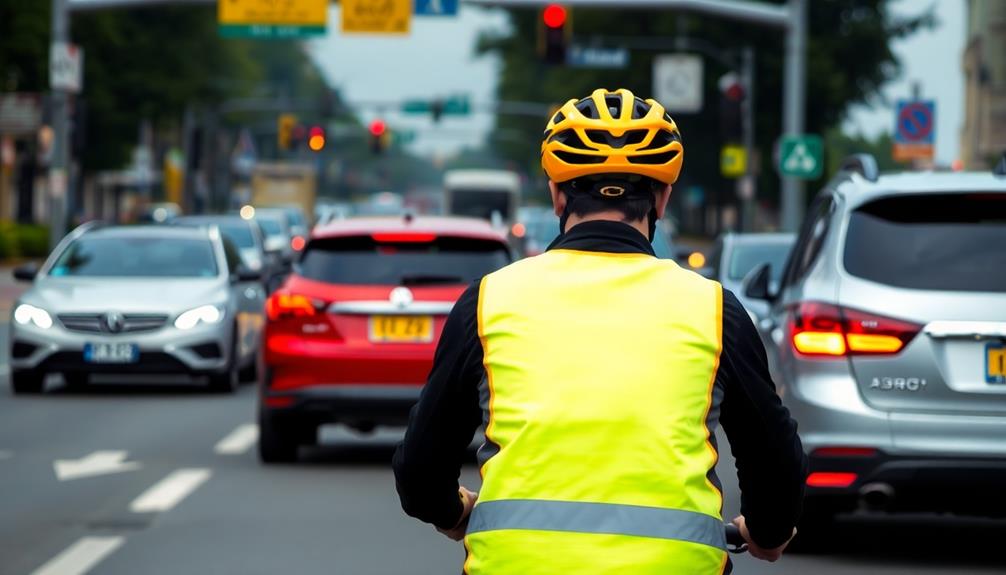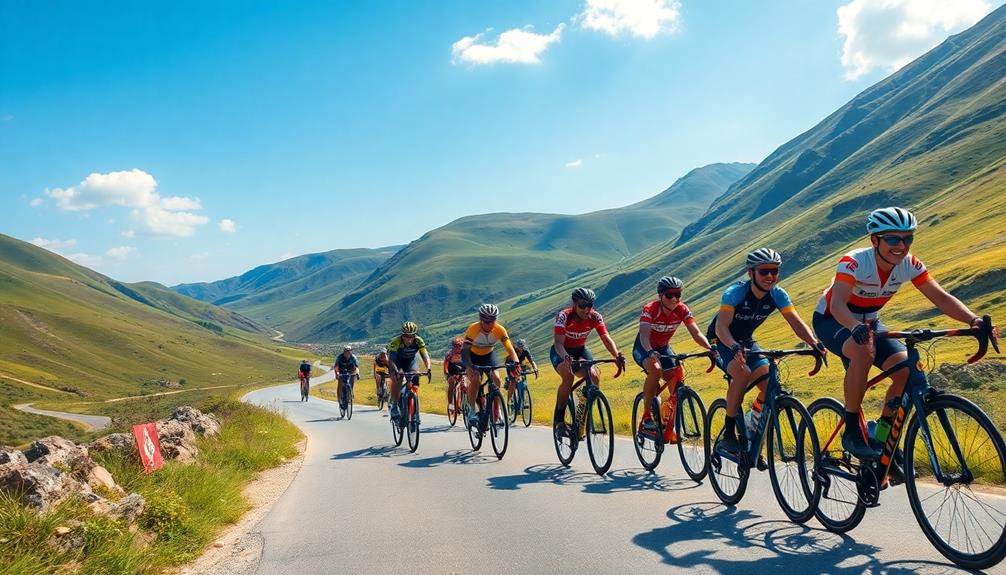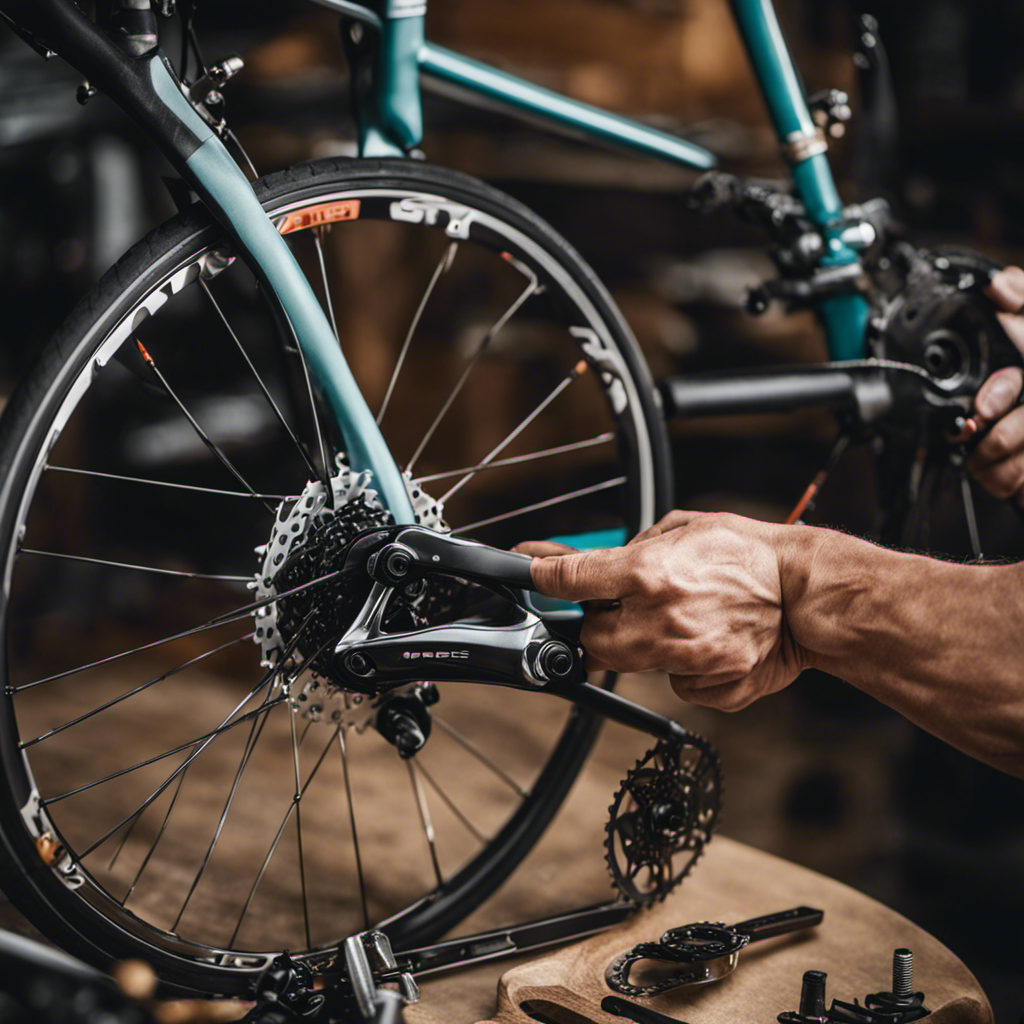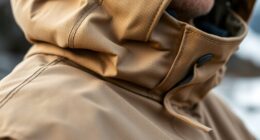To cycle safely in traffic, always follow traffic laws and respect signals. Use bike lanes when available, and ride with the flow of traffic. Wear a properly fitted helmet, bright clothing, and equip your bike with front and rear lights. Keep your movements predictable; avoid sudden actions that could confuse drivers. Always use hand signals to communicate your intentions and make eye contact with drivers to enhance visibility. Watch carefully for turning vehicles at intersections and maintain awareness of your surroundings. For deeper insights into improving your safety on the road, there's plenty more you can explore.
Key Takeaways
- Always obey traffic laws, including signals and stop signs, and ride in the same direction as traffic for safety.
- Wear a properly fitted helmet and bright clothing to enhance visibility and reduce the risk of head injuries.
- Use hand signals to communicate your intentions to drivers, ensuring they are aware of your movements.
- Maintain a predictable riding style; avoid sudden movements to help drivers anticipate your actions.
- Continuously monitor your surroundings and maintain a safe distance from parked cars to prevent collisions.
Understanding Traffic Rules
Understanding traffic rules is important for every cyclist's safety on the road. You must follow the same traffic laws as motor vehicle drivers, including obeying traffic signals and stop signs.
Always use bicycle lanes when they're available, as this greatly enhances your safety. In addition, consider investing in a home security system to guarantee your bicycle is secure when parked. Remember, you should ride in the same direction as traffic to avoid dangerous situations. If there's no bike lane, keep as far to the right side of the road as practical to minimize conflicts with vehicles.
When riding in traffic, signaling your intentions is essential. Use proper hand signals to communicate with drivers and other road users. This simple act can prevent misunderstandings and accidents.
It's also crucial to understand that failing to yield the right of way can lead to serious crashes, making it important to adhere to traffic rules and responsibilities.
Essential Safety Gear
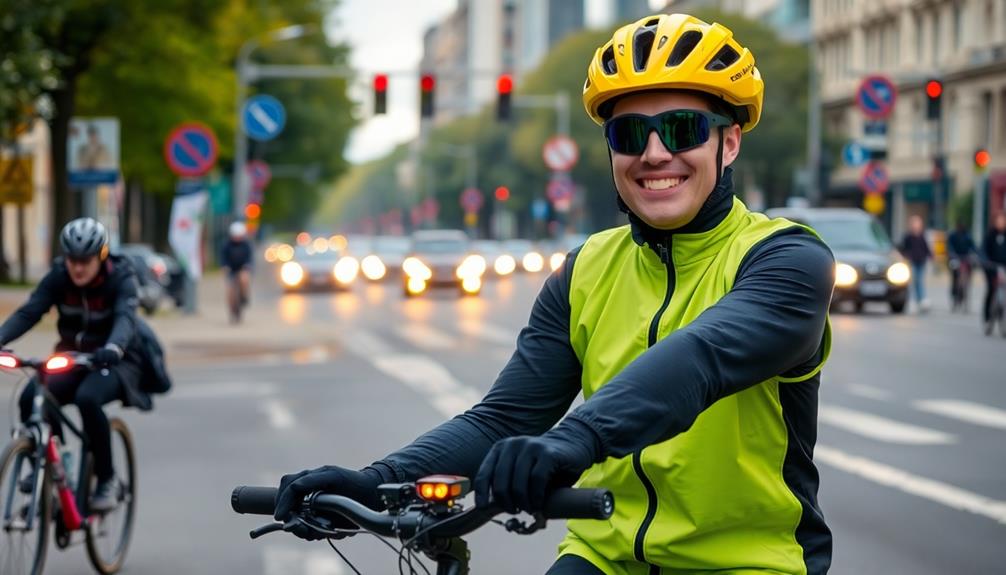
Riding safely in traffic goes beyond just knowing the rules; it also involves wearing the right safety gear. To protect yourself and enhance your visibility, follow these essential safety tips.
| Gear | Importance | Additional Tips |
|---|---|---|
| Properly Fitted Helmet | Reduces head injury risk by up to 85% in crashes | Always check the fit before riding |
| Bright Clothing | Increases visibility to drivers, especially at dusk | Add reflective tape for extra safety |
| Front & Rear Lights | Essential for night riding; often required by law | Confirm they're charged and working |
In addition to the above gear, consider wearing padded gloves and appropriate footwear to improve grip and comfort. This will help reduce fatigue and give you better control while cycling. Don't forget to carry a repair kit with a spare tube, tire levers, and a pump. Being prepared for mechanical issues can make all the difference during your ride. By investing in the right safety gear, you're setting yourself up for a safer cycling experience in traffic.
Riding Techniques for Safety
Safety on the road hinges on your riding techniques, which can considerably reduce the risk of accidents. To guarantee you're safely riding your bike, maintain a predictable riding style. Incorporating skills from primitive weapons for modern survival can enhance your focus and control during rides, helping you maneuver through traffic more effectively.
Avoid sudden movements; this helps drivers anticipate your actions and minimizes collision risks. Keep your hands near the brake levers at all times, enabling quick stops, particularly at intersections where accidents are common.
As you approach intersections, pedal strongly and remain vigilant for turning vehicles, a frequent cause of injuries to cyclists. If you're riding behind five or more vehicles, pull over to let them pass. This promotes smoother traffic flow and reduces potential conflicts, showcasing your rights and responsibilities as a cyclist.
Moreover, avoid passing on the right side of vehicles. This tactic can lead to dangerous situations, especially if a driver turns or opens a door unexpectedly.
Navigating Intersections
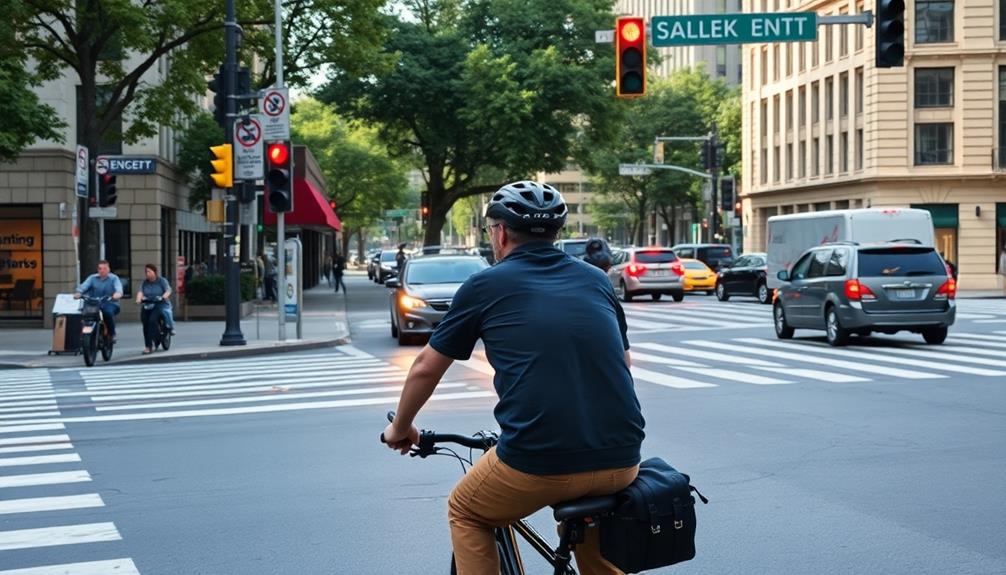
Maneuvering intersections can be one of the most challenging aspects of cycling in traffic. Always wait for a green signal before proceeding; this guarantees you have the right of way and reduces your risk of accidents. As you approach intersections, keep an eye out for turning vehicles and be cautious of blind spots, since many accidents happen when drivers don't see cyclists.
Understanding the importance of budgeting for safety gear can also enhance your overall cycling experience by guaranteeing you're well-equipped.
To communicate your intentions effectively, use hand signals for left turns, right turns, or stops. Make eye contact with drivers whenever possible; confirming they see you can greatly improve your safety. This is especially important in busy areas where distractions abound.
When traversing multi-lane intersections, carefully assess the traffic flow before entering. Only enter when it's safe and confirm you have a clear path to your destination.
Remember, following the rules of the road isn't just for motorists; it's vital for cyclists too. By being vigilant and proactive, you can greatly reduce your chances of encountering dangerous situations while cycling through intersections.
Stay alert, maintain control, and prioritize your safety at every intersection you face.
Communicating With Drivers
When you're cycling in traffic, clear communication with drivers is crucial for your safety.
Just as in relationships, where clear communication during a breakup is important, signaling your intentions can prevent misunderstandings.
Use hand signals to show your intentions and make eye contact to guarantee they see you.
Hand Signals Importance
Clear communication on the road is essential for cyclists, and hand signals play an important role in that exchange. When you're biking in traffic, using hand signals effectively can greatly enhance your safety. They inform drivers of your intentions, helping to prevent accidents.
For instance, to signal a left turn, extend your left arm straight out. If you want to turn right, you can extend your right arm straight out or bend your left arm upward at the elbow. Implementing best practices in safety can help improve your overall cycling experience, much like best practices in software quality assurance enhance software quality.
When you need to stop, extend your left elbow out and downward, with your palm facing behind you. This clear signaling alerts drivers to your intention to slow down or halt.
Making Eye Contact
Awareness is key for cyclists maneuvering traffic, especially at intersections where accidents are most likely to occur. One effective way to enhance your safety is by making eye contact with drivers. This simple action guarantees that both you and the driver are aware of each other's presence, considerably reducing the risk of collisions.
Proper emotional regulation is also critical, as it helps you stay calm and focused in potentially stressful situations, which can improve your decision-making while cycling influences emotional well-being.
Here are some tips to help you make eye contact effectively:
- Position Yourself: Ensure you're in the driver's line of sight, making it easier for them to see you.
- Be Cautious: Look for drivers who mightn't be paying attention; avoid assuming they see you just because you're visible.
- Observe Reactions: After making eye contact, watch for signs of acknowledgment, like a nod or wave, indicating that the driver has seen you.
- Stay Alert: Keep your focus on the traffic around you, allowing for quick reactions if a driver doesn't yield.
Maintaining Predictable Movements
Maintaining predictable movements is essential for ensuring your safety while cycling in traffic. When you ride a bike, your responsibilities include clearly communicating with drivers around you. Always use hand signals to indicate your intentions to turn or stop, as this small action helps drivers anticipate your movements, contributing to the overall flow of traffic.
Additionally, just as AI systems require continuous monitoring for safety and effectiveness, cyclists must remain vigilant and aware of their surroundings to avoid potential hazards continuous monitoring of AI behavior.
Make eye contact with drivers whenever possible. This simple gesture reinforces your presence and intentions, making it less likely that they'll overlook you. Avoid sudden movements or unpredictable maneuvers; staying on a consistent path increases your visibility and reduces confusion for others on the road.
When changing lanes or merging, check over your shoulder for vehicles. Use your signals to clearly indicate your movements, which greatly lowers the risk of collisions.
Additionally, be mindful of your distance from parked cars. Maintaining a safe distance helps you avoid potential dooring incidents, giving you enough space to maneuver if a door suddenly opens.
Engaging With the Cycling Community

Engaging with the cycling community is essential for enhancing your safety and confidence on the road. By connecting with fellow cyclists, you can learn valuable insights about safe riding practices and traffic navigation, as well as discover essential low carb foods that can fuel your rides effectively.
Here are some ways to get involved:
- Join local biking groups: These groups share experiences and tips on safe bike rides, helping you navigate traffic more effectively.
- Participate in community cycling events: These events raise awareness of cyclist rights and educate both cyclists and motorists about safety measures.
- Advocate for better cycling infrastructure: Work collectively to push for dedicated bike lanes and safer crossings, improving safety for everyone on the road.
- Subscribe to newsletters: Stay informed about updates, safety campaigns, and local advocacy efforts from organizations like Bicycle Friendly America.
Frequently Asked Questions
How to Properly Ride a Bike in Traffic?
To ride a bike in traffic, you need to stay aware, follow traffic rules, and signal your movements. Keep a safe distance from parked cars, and always watch for hazards around you. Stay visible, too!
When Cycling on the Road, What Are Some Tips to Follow for Safety?
Cycling's like dancing in traffic; you must flow gracefully. Stay visible, signal intentions, and keep your distance from parked cars. Anticipate movements and wear bright clothing—your safety's the rhythm that keeps you alive on the road.
Should You Cycle With or Against Traffic?
You should always cycle with traffic. It keeps you visible to drivers, reduces accident risk, and helps you anticipate vehicle movements. Riding against traffic can confuse everyone and greatly increases your chances of getting into an accident.
How to Make Road Cycling Safer?
When you glide through the urban landscape, think of safety as your invisible shield. Always wear a helmet, use bike lanes, signal clearly, keep your distance from parked cars, and stay alert to protect yourself.
Conclusion
By following these tips, you can ride confidently and safely among traffic. Think of cycling in traffic like dancing: you need to be aware of your surroundings, anticipate the movements of others, and stay in sync with the rhythm of the road. Just as a dancer communicates with their partner, you'll communicate with drivers through signals and positioning. Embrace the journey, stay alert, and remember, every ride is a step towards becoming a more skilled, confident cyclist.
